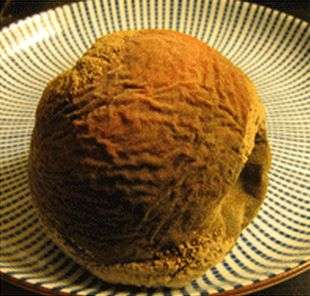Credit: Andrew Dunn/Wikipedia
(Phys.org) —A team of biologists from the U.K., Germany, and Canada has adapted a theory that suggests that microbes cause food to spoil so that larger animals won't eat it. In their paper published in Proceedings of the Royal Society B: Biological Sciences, the team describes how changing one variable added more support to the theory overall.
Humans (and other animals) have known since they first evolved that once fruit (and other food) begins to go bad, it also begins to taste awful—the usual response is to toss the fruit rather than eating it. And that, according to Daniel Janzen in a paper he had published back in 1977, is just what microorganisms are hoping for. By eating fresh fruit and leaving behind chemicals that taste bad, they are ensuring that other animals won't happen by and take the food away from them. Other scientists over time have looked into proving that what Janzen hypothesized was true, but none have been able to do so.
In 2006, a team of researchers came close by building a mathematical model that would show how Janzen's theory works, if it were true. But, in so doing, they found a flaw. In a paper they published, they noted that if some microbes put extra work into making food taste bad to larger animals, it would open the door to other microbes that didn't bother—giving them an advantage. In the end, they decided the awful taste of rotting food was simply the result of food going bad and being eaten by microbes.
In this new effort, the research team revisited the efforts of the team in 2006, but added a new variable—time of arrival by microbes. In the first effort, the researchers assumed that all microbes arrived on the scene at the same time, which would give them all equal footing. But, what if some arrived earlier than others? That would give them a distinct advantage, especially if they left behind chemicals that not only put off larger animals, but other microorganisms who may not be willing to put in the effort to make food taste bad.
This is all still just theory of course, someone still needs to figure out a way to test whether some microbes find food and begin adding chemicals to it before the competition arrives.
More information: Why fruit rots: theoretical support for Janzen's theory of microbe–macrobe competition, Proceedings of the Royal Society B, Published 11 March 2014 DOI: 10.1098/rspb.2013.3320
Abstract
We present a formal model of Janzen's influential theory that competition for resources between microbes and vertebrates causes microbes to be selected to make these resources unpalatable to vertebrates. That is, fruit rots, seeds mould and meat spoils, in part, because microbes gain a selective advantage if they can alter the properties of these resources to avoid losing the resources to vertebrate consumers. A previous model had failed to find circumstances in which such a costly spoilage trait could flourish; here, we present a simple analytic model of a general situation where costly microbial spoilage is selected and persists. We argue that the key difference between the two models lies in their treatments of microbial dispersal. If microbial dispersal is sufficiently spatially constrained that different resource items can have differing microbial communities, then spoilage will be selected; however, if microbial dispersal has a strong homogenizing effect on the microbial community then spoilage will not be selected. We suspect that both regimes will exist in the natural world, and suggest how future empirical studies could explore the influence of microbial dispersal on spoilage.
Journal information: Proceedings of the Royal Society B
© 2014 Phys.org




.jpg)


















